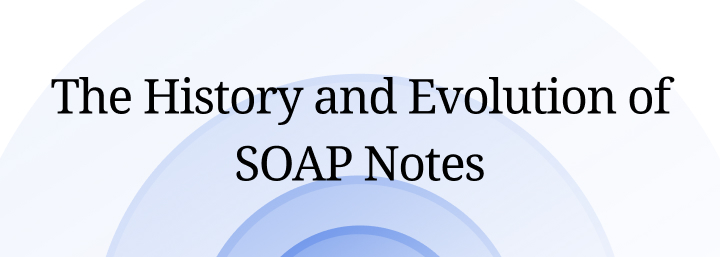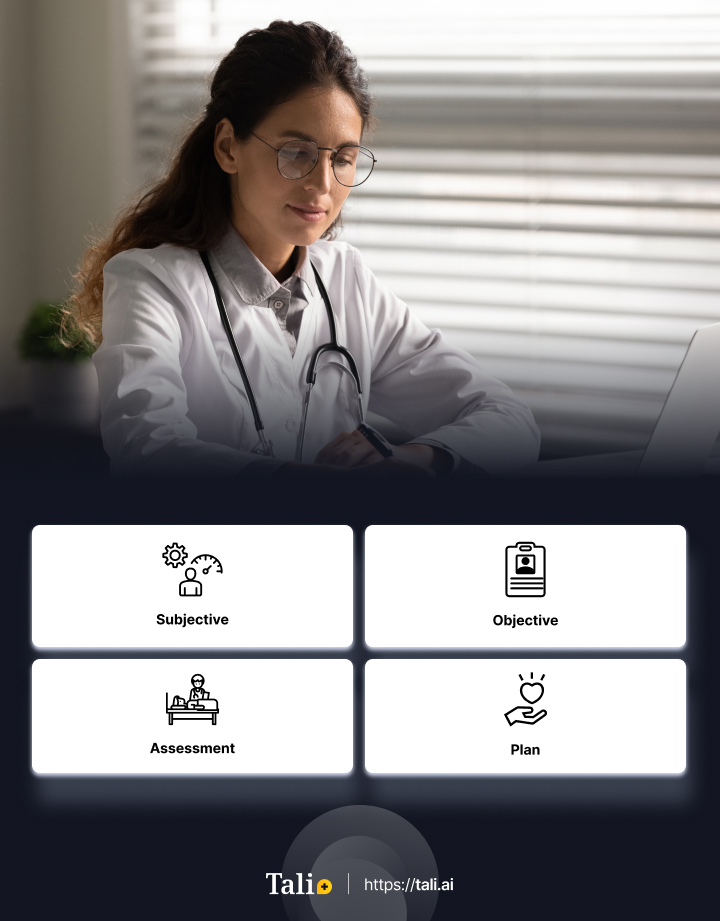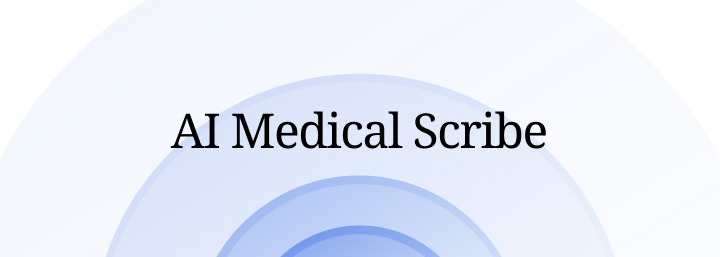What are SOAP Notes?
Table of Contents
In the fast-paced world of modern healthcare, effective communication, and accurate documentation are paramount. Amidst the intricate web of medical jargon, patient histories, and treatment plans, a tool revolutionized how healthcare professionals organize and share vital information: SOAP notes. Short for Subjective, Objective, Assessment, and Plan, they are concise, structured, and standardized records of patient encounters that help clinicians track, assess, diagnose, and treat their patients. But have you ever wondered about the origins of this systematic approach, its evolution over time, and the challenges it presents in today's medical landscape?
The History and Evolution of SOAP Notes

SOAP notes were developed in the 1960s by Dr. Lawrence Weed, a physician and medical educator who pioneered the concept of problem-oriented medical records (POMR). POMR was a revolutionary approach to organizing patient information around specific problems rather than chronological events. Dr. Weed proposed that each problem should be documented using four elements: Subjective, Objective, Assessment, and Plan. These elements formed the acronym SOAP, which became the basis for SOAP notes.
These notes were initially designed for internal medicine, but soon they were adopted by other specialties and disciplines, such as nursing, psychology, physical therapy, and social work. SOAP notes became a standard format for documenting patient care across various settings and contexts.
How SOAP Notes Are Used Today
SOAP notes are still widely used today by healthcare professionals to document patient encounters in various formats, such as paper charts, electronic health records (EHR), or voice recordings. SOAP notes serve multiple purposes, such as:
Providing a clear and consistent way of communicating patient information among different providers and teams
Facilitating clinical decision-making and treatment planning based on evidence and data
Enhancing patient safety and quality of care by reducing errors and omissions
Supporting legal and ethical requirements for documentation and billing
Enabling quality improvement and research activities by generating data and outcomes
The Components and Structure of SOAP Notes

At the heart of effective patient care lies the meticulous organization of information, and SOAP notes provide a structured framework that ensures vital details are captured and communicated seamlessly. Comprising four essential components – Subjective, Objective, Assessment, and Plan – SOAP notes offer a comprehensive method for healthcare professionals to record patient interactions and treatment strategies.
The structure of SOAP notes may vary slightly depending on the clinician's specialty, setting, or preference. However, the general format is to write each component as a separate section with a heading (e.g., S: O: A: P:), followed by a narrative description or bullet points.
Subjective
SOAP notes' "Subjective" component is a gateway to understanding the patient's unique perspective and experiences. This section transcends the clinical data, allowing patients to voice their concerns, emotions, and narratives. Here, healthcare providers lend an empathetic ear to the patient's chief complaints, symptoms, and medical history, unearthing essential information that might not be apparent through objective measures alone. Patients can express their discomfort, fears, and expectations, fostering a sense of partnership in their healthcare journey. The Subjective section contributes to a holistic understanding of the patient and lays the foundation for a personalized and patient-centered approach to diagnosis and treatment. By embracing the patient's story, healthcare professionals can tailor their interventions to address both the medical and emotional aspects of care, ultimately enhancing the overall quality of patient-provider interactions.
Objective
Within the domain of SOAP notes, the "Objective" component introduces an area of empirical data and measurable observations. Here, healthcare professionals transition from the patient's narrative to the realm of quantifiable information, collecting clinical findings, test results, and diagnostic assessments. Objective data is a concrete basis for informed decision-making, providing a clear snapshot of the patient's physiological state. From vital signs and laboratory values to physical examinations and imaging studies, this section enables clinicians to validate hypotheses, identify patterns, and unravel the mysteries of the patient's condition. By grounding medical insights in verifiable data, the Objective component empowers healthcare providers to craft precise diagnoses, devise targeted treatment plans, and monitor progress.
Assessment
The "Assessment" component within SOAP notes is where the pieces of the patient's puzzle start to fall into place. This section serves as the juncture where subjective narratives and objective data converge, allowing healthcare professionals to synthesize information and draw meaningful conclusions. Here, clinicians analyze the presented symptoms, correlate them with objective findings, and comprehensively understand the patient's condition. The Assessment segment represents a pivotal moment of clinical reasoning, where healthcare providers navigate the medical possibilities to identify potential diagnoses or underlying issues. This analysis stage forms the basis for informed discussions with patients, shaping the dialogue around potential treatment options and future steps. By threading the patient's story together with objective evidence, the Assessment component transforms fragmented data into a coherent narrative, guiding healthcare professionals toward the most accurate and effective course of action.
Plan
Within the intricate structure of SOAP notes, the "Plan" component takes center stage as the roadmap for patient care. This section is where healthcare professionals outline the strategic steps that will guide the patient to wellness. Drawing insights from subjective experiences, objective data, and comprehensive assessment, clinicians devise a tailored plan encompassing treatments, interventions, and follow-up measures. The Plan segment bridges diagnosis and action, providing a clear blueprint for medical practitioners to follow. This component ensures that the patient's treatment trajectory is well-defined and purposeful, from prescribing medications and therapies to scheduling further tests or consultations. Additionally, the Plan section promotes continuity of care, offering a reference point for subsequent interactions and enabling healthcare providers to monitor progress and adjust strategies as needed. In essence, the Plan component elevates SOAP notes from a mere documentation tool to a dynamic framework that guides the collaborative efforts of the healthcare team toward achieving optimal patient outcomes.
The Challenges and Limitations of SOAP Notes
SOAP notes are a useful tool for clinical documentation, but they also have challenges and limitations that can affect their quality and efficiency. Some of these challenges and limitations are:
Time and Effort Required for Documentation: Writing SOAP notes can be time-consuming and labor-intensive for clinicians, especially when dealing with multiple patients, complex cases, or large amounts of data. Clinicians may also face difficulties finding time to document during or after patient encounters, which can lead to delays or inaccuracies in documentation.
Potential for Errors and Inconsistencies: Writing SOAP notes can be prone to errors and inconsistencies due to human factors, such as fatigue, distraction, bias, memory lapses, or lack of knowledge. Errors and inconsistencies can also arise from technical factors, such as poor handwriting, illegible transcription, or incompatible EHR systems. These errors and inconsistencies can compromise the quality and reliability of SOAP notes and affect patient care and outcomes.
Difficulty of Sharing and Accessing Information: Sharing and accessing information from SOAP notes can be challenging for clinicians, especially when dealing with different formats, systems, or platforms. For example, paper-based SOAP notes can be easily lost, damaged, or misplaced, while electronic SOAP notes can be affected by network issues, security breaches, or compatibility problems. These challenges can hinder communication and collaboration among different providers and teams and affect the continuity and coordination of care.
The Solution: AI Medical Scribe

In an age of rapid technological progress, the healthcare sector embraces inventive solutions to streamline operations and elevate patient care. The AI Medical Scribe harnesses the capabilities of artificial intelligence to aid in the documentation process, providing real-time transcription, analysis, and organization of patient interactions. By automating the data entry tasks that often consume valuable time, AI Medical Scribes empower healthcare providers to dedicate more attention to direct patient engagement and crucial decision-making. With the ability to precisely capture patient narratives, synthesize objective data, and even propose potential diagnoses or treatment options, this solution can revolutionize the efficiency and precision of SOAP notes, ultimately enhancing the overall quality of patient care.
An AI medical scribe can offer a solution to the challenges and constraints of SOAP notes by:
Simplifying Documentation Efforts: An AI medical scribe can automate the documentation process, alleviating clinicians from the burden of note-taking. Clinicians can converse naturally with their patients while the AI medical scribe captures, transcribes, and organizes relevant details in the SOAP note structure. This efficiency saves time and energy for clinicians, allowing them to concentrate more on patient interactions.
Enhancing Documentation Accuracy and Uniformity: This system bolsters the accuracy and uniformity of documentation through advanced algorithms, machine learning, and natural language processing, which analyze and process information from patient encounters. It also employs rigorous quality control mechanisms to validate and ensure the reliability of SOAP notes. This curtails errors and discrepancies in documentation, heightening patient safety and the quality of care provided.
Facilitating Information Sharing and Accessibility: An AI medical scribe facilitates seamless sharing and access of information via a secure, cloud-based platform that integrates smoothly with existing EHR systems. Certain systems incorporate a voice-enabled interface, enabling clinicians to access or modify SOAP notes using voice commands. This fosters better communication and collaboration among diverse providers and teams, refining care continuity and coordination.
Conclusion
SOAP (Subjective, Objective, Assessment, and Plan) notes serve as indispensable tools in the realm of healthcare documentation. Their structured format aids healthcare providers in recording vital patient information. However, like any system, SOAP notes come with their own set of challenges and limitations that can sometimes hinder their effectiveness.
Integrating artificial intelligence (AI) into the healthcare landscape has emerged as a promising solution to addressing these challenges and limitations. AI-driven medical scribes have the potential to revolutionize the way healthcare professionals document patient encounters. By harnessing the power of artificial intelligence, these virtual assistants can streamline and enhance the entire documentation process.
In conclusion, while SOAP notes play a crucial role in healthcare documentation, they come with challenges and limitations. Embracing the power of AI through medical scribes represents a transformative solution that can enhance the quality and efficiency of documentation. With AI's assistance, healthcare professionals can streamline their workflow, improve records' accuracy, and ensure that patient information is readily accessible when and where it's needed most.
If you are looking for an AI medical scribe who can help you easily create high-quality SOAP notes, look no further than Tali. Tali is an AI-powered, voice-enabled digital assistant that streamlines administrative tasks and accesses necessary patient data from the EHR with remarkable speed and accuracy. Tali's natural language processing capability allows you to speak naturally without memorizing specific commands. As a result, you can quickly adapt Tali to your workflows and enjoy the benefits of Tali's AI medical scribe.
Tali’s AI medical scribe can help you:
Save time and effort by automating documentation
Enhance patient care by focusing more on your patients
Reduce errors and inconsistencies by improving documentation quality
Boost satisfaction by reducing stress and burnout
Don’t miss this opportunity to transform your practice with Tali’s AI medical scribe. Experience the benefits of Tali with our free trial today!
In the modern healthcare landscape, effective communication and accurate documentation are paramount. SOAP notes, short for Subjective, Objective, Assessment, and Plan, play a crucial role in organizing and sharing vital patient information. Dr. Lawrence Weed developed SOAP notes in the 1960s as part of the problem-oriented medical records (POMR) approach, revolutionizing how healthcare professionals document patient encounters. These structured and standardized records help clinicians track, assess, diagnose, and treat their patients across various specialties and settings. They provide a clear and consistent way to communicate patient information among different providers, enhance patient safety, support legal and ethical requirements, and enable quality improvement and research activities.
SOAP notes have four essential components: Subjective, Objective, Assessment, and Plan. Each component serves a specific purpose in documenting patient interactions and treatment strategies. The Subjective component allows patients to express their concerns, emotions, and medical history, fostering a patient-centered approach to diagnosis and treatment. The Objective component focuses on empirical data and measurable observations, providing a concrete basis for decision-making. The Assessment component synthesizes subjective narratives and objective data to comprehensively understand the patient's condition, guiding discussions around potential diagnoses and treatment options. Finally, the Plan component outlines the strategic steps for patient care, ensuring a well-defined and purposeful treatment trajectory. This structured framework facilitates seamless communication and collaboration among healthcare providers.
While SOAP notes are invaluable for clinical documentation, they come with challenges such as time and effort required for documentation, potential errors and inconsistencies, and difficulty sharing and accessing information. AI Medical Scribes offer a promising solution to these challenges by automating documentation, enhancing accuracy and uniformity, and facilitating information sharing and accessibility. They simplify the documentation process, allowing clinicians to focus more on patient interactions, improve the accuracy of records, and ensure better communication and collaboration among healthcare teams. AI Medical Scribes, like Tali, offer efficient and accurate assistance in creating high-quality SOAP notes, ultimately enhancing the quality and efficiency of healthcare documentation.
Documentation and Administrative Tasks?